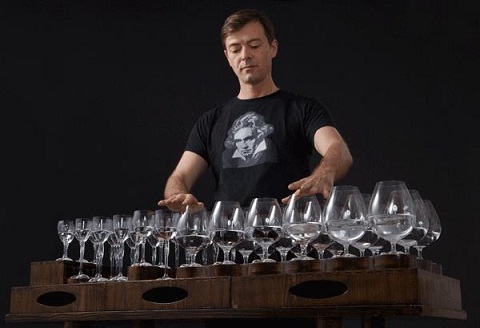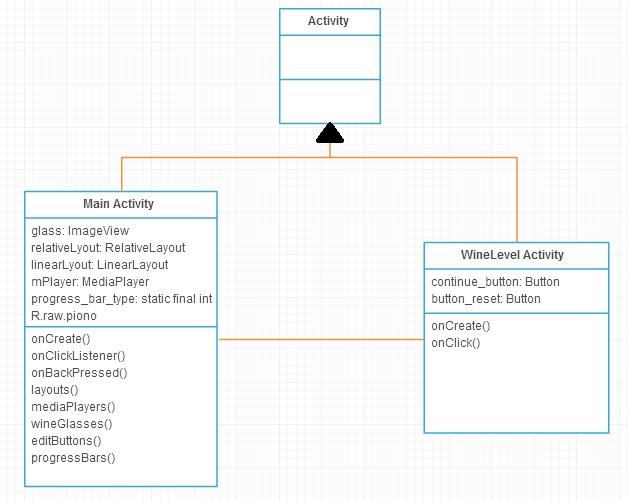





Published on Mar 01, 2025
One among the many inventions of Benjamin Franklin is the Glass Armonica, a musical instrument whose sound source was a series of resonating glass vessels. However, the Irish musician Richard Pockrich is typically credited as the first to play an instrument composed of glass vessels, called the Glass Harp in 1741, by rubbing his fingers around the rims. In this project “Singing Wine Glasses”, the principle of Franklin’s glass armonica is demonstrated with a wine glass. One hand is used to hold the glass steady at the base.
The rim of glass is gently pressed with a moistened finger of the other hand and drawn in a circle around. When the pressure and amount of moisture are just right, the slight friction between the finger and the rim of glass causes vibrations in the sides of the glass. At a particular frequency, called the resonant frequency, the sides of the glass will vibrate most easily.
The resonant frequency of wine glasses is typically within the range of human hearing (20-20,000 Hz), so the resulting resonant vibration is heard as a tone. The glass starts to sing when the vibration gets the molecules moving at their natural frequency. The resonant frequency changes with the amount of water filled in the glass. This android application deals with virtual glasses that serve the purpose of wine glasses filled with different amounts of water. Swiping on the glass edges would produce music, as per Franklin’s principle. The users would be free to select the number of glasses they want to play, and the amount of water-level in each glass. This application would also come with an enhanced feature of sustaining a particular note until the finger is released from the glass.
Singing Wine Glasses is an Android application that allows users to play music on a series of virtual glasses, each with a certain amount of water filled in it. The original idea came from the Glass Harp, which is the predecessor of Benjamin Franklin’s Glass Armonica. Glass Harp brings music to life in a rather unusual and an enchanting way. Swiping our fingers expertly in a circular motion along the edge of the glasses produces different sounds rendering great music!
One among the many inventions of the famous statesman, scientist, democrat, printer and inventor – Benjamin Franklin – is the Glass Harmonica, a musical instrument whose sound source was a series of resonating glass vessels.[1] However, an Irish musician Richard Pockrich, in 1741, popularized the use of wet fingers and friction to induce music out of an array of glasses. The instrument was called the Glass Harp. Although the Glass Armonica was invented by Benjamin Franklin in 1761, Richard Pockrich is typically credited for playing the first ever instrument composed of glasses, the Glass Harp (Glass Armonica's ancestor), by rubbing his fingers around the rims.

The principle of Glass Harp can be demonstrated using a wine glass. One hand is used to hold the glass steady at the base and the rim of the glass is pressed gently with moistened finger of the other hand and ran around the rim of the glass. When the pressure and amount of moisture are just right, the slight friction between the finger and the rim of the glass causes vibrations in the sides of the glass. At a particular frequency, called the resonant frequency, the sides of the glass vibrate most easily. Since the resonant frequency of the glasses typically lie within the range of human hearing, the resulting resonant vibration is heard as a tone.
The glass starts to sing when the vibration gets the molecules moving at their natural frequency. Each glass produces a different note that differs based on the size and shape of the glass or the amount of water-level in it. Sound travels much slowly through water than it does through glass which implies that an empty glass resonates at a much higher frequency than a glass with water in it. In simpler terms, the more water the glass contains, the lower the frequency - and thus the lower the note it will produce when rubbed.
Singing Wine Glasses is an android application that makes one "exp-ear-ience" the captivating vibrations we call music. The unique way of producing music with the common glassware found at home, lured me to develop an application that provides a virtual interface for all music lovers out there to produce enthralling tones with a simple swipe of their fingers.
The application deals with virtual glasses that serve the purpose of wine glasses filled with different amounts of water.
Swiping on the glass edges would produce music, as per Franklin's principle.
The users would be free to select the number of glasses they want to play, along with the amount of water-level in each glass.
This application would also come with an enhanced feature of sustaining a particular note until the finger is released from the glass.
Requirements Gathering is the most crucial part of a project. A developer needs to completely understand what a project does, to deliver it with success. Singing Wine Glasses Application started with the idea of Dr. Daniel Andresen, who also provided me with an initial overview of the app’s requirements. I downloaded and experimented with various applications related to Glass Harp and other instruments, and tried to anticipate what all features an instrumental app generally has. Then, I tested the available applications in all possible ways and observed few drawbacks in those apps. I tried to beat those flaws and design my application to make it loved by all the users. And my thought process was further enhanced by Dr. Andresen.
The important requirements for the project are as follows
Virtual glasses serve the purpose of wine glasses filled with different amounts of water.
Swiping on the glass edges produces music.
Users would be free to select the number of glasses they want to play music with along with the amount of water-level in each glass.
It would also have an enhanced feature of sustaining a particular note until the finger is released from the glass.
Application Development Life Cycle describes the process of planning, creating, testing and deploying a particular application. Requirements gathering is the initial and the most crucial part of the application development life cycle. The other phases include planning, designing, developing, integration and testing, implementing, deployment and maintenance.
An Android smart device with 2.2 or a higher version
A processor with Pentium IV or higher
512 MB RAM
250 MB or higher Disk Space
Operating System: Windows XP, Vista or higher, Mac OS 10.6 or later, Ubuntu 10.4 (Linux)
Platform: Android SDK with an API of 10 or higher
Tools: Android Studio 1.1.0, Git distributed version control system
Technologies: Java, Android
A class diagram is a structural diagram that represents the static view of an application and visualizes different aspects of a system along with constructing an executable code of the software application. It describes the attributes and operations of a class and the constraints imposed on the system. A class diagram is a collection of classes, interfaces, associations, collaborations and constraints.

The class diagram that I designed for my application – Singing Wine Glasses – is shown and explained below.
Singing wine glasses has two main classes – MainActivity and WineLevelActivity that extend the Activity class, that takes care of creating a window to place UI for the application. Both the classes have a set of variables and methods embedded in them. MainActivity has ImageView, RelativeLayout, LinearLayout, MediaPlayer objects and methods like onCreate(), onClickListener(), onBackPressed(), etc. It has listeners for each event that decide the activity to be performed for each action the user does. This class deals with the main musical instrument screen where the music is played and the navigation bars to go to the glasses and water-level selector screen.
WineLevelActivity has Button objects and onCreate() and onClick() methods. This class has methods that deal with the glass and the water-level selector screens. It has listeners to the actions performed by users on trying to change the water-level in the glass.
Singing Wine Glasses is an Android application that is a virtual representation of the musical Glass Harp, invented by Richard Pockrich in 1741. It is a great application for all the music lovers, who love experimenting with different instruments, without the pain of setting up any apparatus or buying a new instrument altogether. It is a pretty much mess-free application.
Music is actually produced in the application with a media player that has notes assigned to each level of water in the glass ranging from 10 - 100%. The lower the level, the more the frequency, and hence, higher the note assigned. Real piano notes were recorded and synthesized for the musical notes of this application. The notes almost produce the same tones as the real Glass Harp.
The different modules included in the Singing Wine Glasses that serve different functionalities are as follows:
Instrument
Glass Selector – Reducing the number of glasses
Glass Selector – Increasing the number of glasses
Water-level Selector
Progress Bar
Music sustainability
Singing Wine Glasses is an excellent application for all music lovers out there to experiment with a new and a different kind of musical instrument. Who could have imagined that the common glassware found on the table could produce such breathtaking music!! This is a very user-friendly application. The application provides an interface that makes it easy for the users to set up the instrument. It is highly portable and reduces the risk of moving the entire apparatus from one place to the other without breaking it. This application also has an edge over several other musical apps related to Glass Harp, since it is more flexible and dynamic. Singing Wine Glasses is sure to leave the users with a wonderful musical “exp-ear-ience”!!
Singing Wine Glasses still hold a scope of improvement. It can be further enhanced with the following features:
The app can be made to record the music played by the user.
The recorded music files can be shared via social media.
The app can be further enhanced to include an option for selecting the type of the glass, since music varies with the type of the glass too.
The user interface can be further improved with 3-d image drawing.
The app can be made to support other platforms, like iOS.
Further improvement can be made with the sustainability of the music.
Different flavors ranging from classical to lush violin and sweeping synthesizers can be included.
1. Science Buddies. (October 6, 2014). Singing Wine Glasses. from http://www.sciencebuddies.org/science-fair-projects/project_ideas/Music_p008.shtml
2. Wikimedia Commons (n.d.). Glass Harp Image. Retrived Jan 12, 2013, from http://commons.wikimedia.org/wiki/File:Robert_tiso_glass_harp_beethoven.png
The file is made availalble under Creative Commons CC0 1.0 Universal Public Domain Dedication
3. Wikimedia Commons (n.d.). GlassArmonica Image. Retrieved April 17, 2012, from http://commons.wikimedia.org/wiki/File:Glassarmonica.jpg The file is released into public domain worldwide